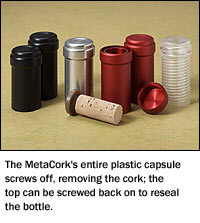
|
that plug of bark! ......is the Cork Age over?
By: Thomas M. Ciesla |
|
| |
 The Stelvin Screw Cap Closure |
SCREW IT! The screw-cap was invented by an Englishman around 1889 and was used as a wine closure as early as the 1940s by the Gallo wine company. The Stelvin screw-cap enclosure was created by the French firm Pechiney and adopted by the airline industry in the 1970s. In the late 1980s winemakers in Australia and New Zealand experimented with the Stelvin, but abandoned the effort to due poor acceptance. Then, as wine production increased around the world straining cork supplies, and spiraling incidents of TCA contamination created a renewed interest in the screw-cap. Today, Australian and New Zealand winemakers are moving en masse to screw-caps and increasingly are being joined by winemakers in California and even France, though the French have been somewhat reluctant to make the turn. The Swiss embraced screw-caps for their wines decades ago and today the closure is used on 70% of Swiss wines. Increased interest in screw-caps for mid-to-premium wines has created alternatives to the 'Stelvin closure'. The Stelvin screw-cap is technically known as ROPP Rolled On Pilfer Proof, as opposed to the TOPP style Torqued On Pilfer Proof. What's the difference? The TOPP enclosure is actually a sheath that twists off and hides the threads of the screw- cap, providing a more aesthetic look. Aesthetics are a big concern for winemakers, who while trying to break a centuries old tradition, also want customers to accept the new enclosures.
|

|
Metacork is a new technology that combines traditional cork with screw-caps, often referred to as a 'twist capsule'. The unique design has a built-in cork anchor that allows you to remove a cork or synthetic stopper with nothing more than a few twists of the capsule. Another twist on non-cork closure comes from Australian inventor Conor McKenna, called the ZORK. It is similar to a crew cap in the way it seals and it is made of material that won't taint the wine. The ZORK snaps on to the glass band found on traditional wine bottles. Once the aluminum seal is broken, a plunger is pulled out by hand, making that satisfying pop. The plunger, which is similar to those used on inexpensive Ports, allows the bottle to be resealed after opening. The Alcoa Company has taken this concept a step further by creating a completely inactive glass stopper to reseal the wine. The product called Vino-Lok, is made of glass and fits into a wine bottle the way a decanter stopper does. |

